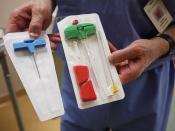Anesthetics are used to block pain or other sensations from a patient as they undergo a surgery. This helps the patient go through procedures with little or no distress as they would feel otherwise. In this paper I will discuss the types of anesthesia, how each works, and give a little background on anesthetics.
There are four broad categories of anesthesia: general anesthesia, regional anesthesia, local anesthesia, and sedation. General anesthesia is issued for the reversible loss of consciousness and effects the brain cells. Regional anesthesia effects a large bundle of nerves on a particular area of the body, which results in losing sensation to that area without affecting your level of consciousness. Local anesthesia is similar to regional anesthesia in that it is used for the reversible loss of sensation in part of the body. Sedation can be given in many ways. A common example of an anesthetic gas used for sedation is nitrous oxide or "laughing gas".
Anesthetics have been in use since prehistory. Back then, however, they used only simple herbs such as opium and hemp. These were either burned or their smoke was inhaled. In Asia, it was also popular to administer anesthetics by way of acupuncture.
The modern use of anesthesia began when the anesthetic qualities of nitrous oxide were discovered by the British chemist Sir Humphry Davy during the 1800's. This gas was used in 1844 for painless tooth extraction by American dentist Horace Wells. In 1842 in Georgia, Dr. Crawford Williamson Long was the first to use anesthesia during an operation. He used ether to aid his wife during childbirth. Five years later, in 1847, Sir James Simpson discovered the anesthetic use of chloroform.
General anesthetics produce an unconscious state in which the person is: unaware of what is happening, pain-free, immobile, and...


